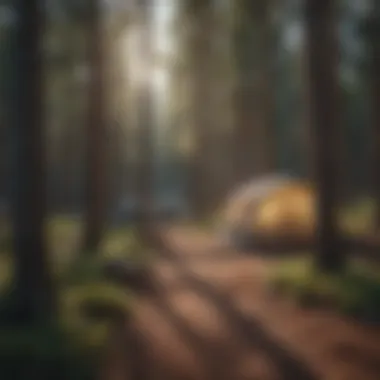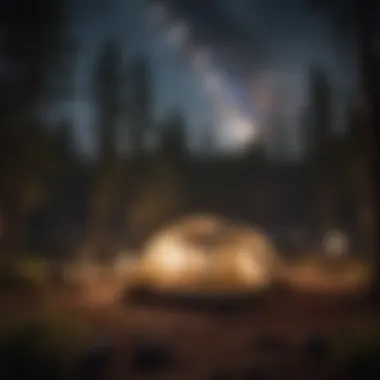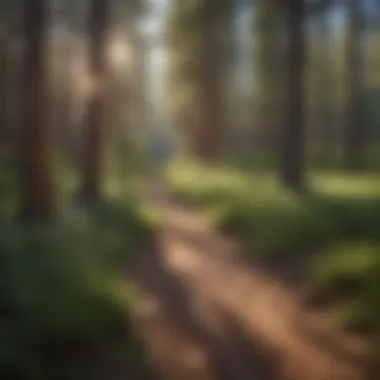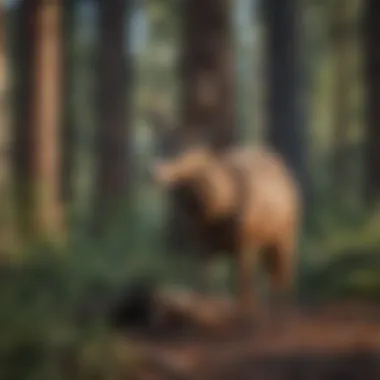Exploring Camp Grounds in Flagstaff, AZ: A Comprehensive Guide


Intro
Flagstaff, Arizona is a gem in the heart of the Southwest, surrounded by ponderosa pines and diverse landscapes. The area offers a wealth of campgrounds, each possessing unique qualities that cater to a variety of outdoor interests. Therefore, understanding these locations involves more than simply listing amenities; it also necessitates an exploration of the ecological significance of the woodland ecosystems that form the backdrop of these outdoor experiences.
As we delve into the numerous campgrounds in the Flagstaff region, this guide aims to inform outdoor enthusiasts and forestry professionals alike. By examining the biodiversity present in these forests, the role of sustainable practices, and the techniques employed for woodland stewardship, readers can gain a deeper appreciation for both camping and conservation.
This exploration will shed light on the intersection between recreational opportunities and environmental responsibilities, thereby enhancing our understanding of outdoor experiences in tandem with forest conservation efforts.
Preamble to Camping in Flagstaff, AZ
Camping in Flagstaff, Arizona, provides not just an opportunity to explore nature but also an experience deeply entwined with environmental appreciation. Understanding the nuances of camping in this region is vital for enthusiasts, while also guiding forestry professionals in their stewardship efforts. The unique ecological landscape involves diverse ecosystems, each offering campers a distinctive experience. Hence, this chapter aims to deliver insight into the essence of camping here, emphasizing why it's worthy of consideration for both recreation and conservation.
The Importance of Woodland Areas
Woodland areas serve as vital ecosystems in Flagstaff, acting as habitats for various flora and fauna. They are essential in maintaining ecological balance while also providing recreational spaces for camping. This symbiotic relationship between nature and recreation highlights the need for responsible usage of these spaces. The forests, particularly those in Coconino National Forest, contribute significantly to air quality and biodiversity. Campers benefit from immersion in these surroundings, offering unique opportunities for wildlife observation and photography. From towering ponderosa pines to vibrant wildflower blooms, each location holds its own charm, enhancing the camping experience.
Overview of Flagstaff's Natural Features
Flagstaff's geographical setting, positioned at a high elevation, contributes to its diverse climate and abundant natural features. The volcanic landscape is dotted with mountains, canyons, and serene lakes.
- San Francisco Peaks dominates the skyline, offering hiking opportunities.
- Walnut Canyon showcases impressive geological formations and rich history.
- Lakes Mary and Ashurst provide water-based activities that expand options beyond traditional camping.
These elements interweave to create a unique backdrop for campers, inviting exploration and adventure. The interplay of diverse ecosystems, including ponderosa pine forests, alpine meadows, and high desert areas, enhances the attractiveness of camping in Flagstaff. Understanding these natural features is key for both casual adventurers and professionals devoted to the conservation of nature.
Geographical Context of Flagstaff
Understanding the geographical context of Flagstaff is essential for outdoor enthusiasts and professionals focusing on forestry and conservation. The interplay between elevation, climate, and surrounding ecosystems not only influences the local flora and fauna but also shapes the camping experience in the area. An informed perspective on these factors enhances the appreciation and responsible use of the land.
Elevation and Climate
Flagstaff is situated at an impressive elevation of approximately 7,000 feet (2,134 meters) above sea level. This altitude moderates the local climate. With cooler temperatures than neighboring lower desert areas, Flagstaff experiences a distinct four-season climate. Winter brings significant snowfall, transforming the landscape and creating opportunities for winter activities, while summer often provides mild temperatures ideal for camping.
The climatic variations affect the available recreational activities. Hikers and cyclists should consider seasonal changes when planning their outings. Warmer months often attract larger crowds, while the colder months can present challenges like snow and ice. As a result, individuals should check weather forecasts and prepare accordingly. Each season uncovers unique opportunities and challenges in this ecological region.
Surrounding Ecosystems
The ecosystems around Flagstaff are diverse and rich. From ponderosa pine forests to alpine tundras, the surrounding landscapes offer a complex web of habitats. This biodiversity provides a multitude of opportunities for wildlife viewing and studying various ecological processes. Understanding these ecosystems is fundamental for responsible camping and conservation practices.
The Coconino National Forest surrounding Flagstaff exemplifies this diversity. It is dotted with various campgrounds that allow easy access to these ecosystems. Moreover, awareness of the balance within these habitats is crucial. Campers are encouraged to respect wildlife, including deer, elk, and a range of bird species, all of which thrive in this region.
"The unique elevation and diverse ecosystems of Flagstaff contribute significantly to the recreational and conservation value of the area, making it a destination for both leisure and education."
Regulations and Permissions for Camping
Understanding regulations and permissions for camping is crucial for anyone planning to visit the campgrounds in Flagstaff, AZ. These regulations not only safeguard the natural environment but also ensure a safe and organized experience for all campers. Each campground has its own set of rules, which are designed to protect wildlife, preserve natural resources, and maintain the beauty of the area. Therefore, adhering to these regulations is essential for conservation as well as personal enjoyment.
Permits and Reservations


In many campgrounds around Flagstaff, a permit is required for camping. This typically includes both backcountry and established sites. Obtaining a permit helps manage the number of visitors, preserving the area's natural beauty and minimizing human impact. Most campgrounds allow reservations to be made ahead of time, which is highly recommended, especially during peak seasonal months. This ensures a guaranteed spot and reduces overcrowding.
The process for obtaining a permit usually involves filling out a form online or at designated local offices. Be mindful that some campgrounds have specific guidelines regarding the number of tents or vehicles allowed per site. There might also be fees associated with permits, which help fund ongoing maintenance and conservation efforts.
Leave No Trace Principles
The Leave No Trace principles are fundamental to promoting responsible camping practices. These guidelines aim to minimize the human footprint on nature, allowing the ecosystems to thrive undisturbed. Here are some core tenets of these principles:
- Plan Ahead: Preparation is essential to ensure a smooth and respectful experience.
- Travel and Camp on Durable Surfaces: This includes established trails and campsites to prevent soil erosion.
- Dispose of Waste Properly: Pack out what you pack in, including trash and food waste. This minimizes contaminants in the area.
- Leave What You Find: Preserve the environment by not removing plants or historical artifacts.
Adhering to the Leave No Trace principles not only enhances camper responsibility, but also profoundly impacts the region's ecological preservation. By encouraging these practices, campers can collectively contribute to the longevity of the natural beauty surrounding Flagstaff and ensure its availability for future generations.
"Respect for nature is essential for any outdoor activity. Understanding regulations and practicing Leave No Trace can keep our wilderness areas preserved."
By following these regulations and principles, campers play an active role in maintaining the integrity of Flagstaff's campgrounds while enjoying the myriad outdoor experiences available.
Detailed Review of Camp Grounds
A comprehensive examination of camp grounds presents a valuable resource for both casual campers and forestry professionals. Understanding the diverse characteristics of these locations can aid in selecting the perfect spot for recreation and relaxation, while also respecting ecological processes at play. Each site not only provides amenities and activities but also serves a part in the conservation narrative of the Flagstaff area. By exploring specific campgrounds, we can recognize their unique offerings and how they fit into the larger camping landscape.
Lockett Meadow Campground
Location and Accessibility
Lockett Meadow Campground is situated within the stunning landscape of the San Francisco Peaks. Its accessibility is a key element that contributes to its popularity. The campground can be reached via a maintained dirt road, suitable for most vehicles, but caution is advised in the rainy season. The ease of access encourages many outdoor enthusiasts to explore the area. As an advantageous feature, it is in proximity to various trailheads, adding an element of convenience for hikers looking to explore.
Amenities Offered
The amenities available at Lockett Meadow Campground enhance the camping experience significantly. Visitors can expect basic facilities such as picnic tables, fire rings, and bathrooms equipped with vault toilets. However, there is no drinking water source available on-site, which requires advance planning by campers to bring sufficient supplies. This campground is indeed favored for its serene atmosphere and well-defined sites that provide privacy.
Surrounding Nature Trails
One of the standout characteristics of Lockett Meadow is the accessibility of surrounding nature trails. These trails offer various difficulties, making them suitable for different skill levels. The popular Inner Basin Trail starts from the campground, providing breathtaking views and a chance to experience diverse flora. However, the potential for crowded trails, especially during peak season, can detract from the overall experience.
Bonito Campground
Unique Features of Bonito
Bonito Campground is known for its unique volcanic landscape. The variety of geological formations attract visitors interested in both camping and geology. Featuring sites nestled among tall pine trees, the campground blends recreational space with natural beauty. On the other hand, the benefits of this unique setting come with challenges, such as potential debris from overhead branches.
Wildlife Viewing Opportunities
Wildlife viewing at Bonito is notable. Campers often have the chance to see deer, elk, and various bird species. The abundance of wildlife can greatly enhance the experience. However, it is important for visitors to follow best practices for wildlife observation, ensuring that animals are not disturbed or fed, which is crucial for their safety and ecosystem balance.
Seasonal Considerations
Bonito Campground sees a range of seasonal changes that campers must consider. Summer months are popular due to mild temperatures and beautiful scenery. Conversely, winter storms can make access difficult. Understanding these seasonal nuances is essential when planning a visit, as conditions can vary significantly.


Lake Mary Campgrounds
Proximity to Water Bodies
Lake Mary Campgrounds boast a prime location near freshwater sources, enhancing the appeal for fishing and recreation. The proximity to both Lake Mary and Lake Michelle provides ample opportunities for boating, fishing, and swimming. While this location is favored for water activities, it is essential to monitor weather conditions, as heavy rains can lead to fluctuating water levels.
Recreational Activities Available
The array of recreational activities available at Lake Mary is considerable. From paddleboarding to hiking along shoreline trails, the campground encourages outdoor engagement. Its appealing features contribute to its popularity, though increased foot traffic can affect the tranquility of the area at times, especially on weekends.
Family-Friendly Amenities
Lake Mary Campgrounds cater well to families with amenities designed for children, such as designated play areas and family-sized camping spots. The availability of restrooms and easy access to water enrich the family camping experience. However, visitors should be aware that reservation spots fill quickly during holidays.
Coconino National Forest Campgrounds
Site Variability and Options
Coconino National Forest offers a multiplicity of camping sites. This variability allows for unique camping experiences based on preferences and needs. Sites range from primitive campgrounds without amenities to developed ones with full facilities. The diversity provides options for those looking for a solitary experience or a more social environment.
Ecological Significance
The ecological importance of Coconino National Forest cannot be overstated. It hosts diverse ecosystems with varying flora and fauna. Each campground contributes to the preservation of these environments. Campers have a role in this too, as responsible practices can support conservation efforts, although not all visitors are aware of their impact.
Community Engagement Programs
Community engagement at Coconino National Forest encourages campers to participate in local conservation efforts. Programs often involve guided educational workshops and volunteer days, fostering a sense of stewardship among visitors. While appealing, participation may require advance sign-up, making it critical for those interested to plan accordingly in advance.
Activities and Highlights for Campers
The array of activities available for campers in Flagstaff, AZ enhances the overall outdoor experience. Engaging in various pastimes not only provides entertainment but also fosters a connection with nature. It is crucial to consider how each activity promotes physical well-being, ecological awareness, and community interaction. In this section, we will explore these activities, focusing on hiking, biking routes, and wildlife observation.
Hiking and Nature Trails
Hiking in Flagstaff is a favored activity, attracting both beginners and experienced trekkers. The city is surrounded by diverse mountain landscapes, offering trails that range from easy walks to strenuous climbs. Notable hikes include the Inner Basin Trail and the popular Humphreys Peak. These trails not only promise panoramic views but also serve as avenues for physical fitness.
Benefits of Hiking:
- Health Improvement: Hiking is an excellent way to maintain physical health. The various trails challenge different muscle groups.
- Ecological Understanding: Many trails pass through diverse ecosystems, exposing hikers to local flora and fauna.
- Mental Clarity: Engaging with nature has been shown to reduce stress and increase mental well-being.
When hiking, it’s diffcult to overlook the importance of being prepared. Good footwear, ample water, and awareness of local wildlife are essential considerations. Additionally, it's wise to check the trail conditions online before heading out to prevent disappointment.
Biking Routes and Restrictions
Biking routes in Flagstaff are well-marked and varied, catering to all skill levels. Mountain biking trails are especially popular. The Coconino National Forest offers numerous paths, such as the Arizona Trail, that provide both scenic views and challenging terrain. Campers should also be aware of particular restrictions that apply to biking in specific areas.
Key Points About Biking:


- Trail Types: Biking routes range from smooth unpaved paths to rough terrains, making it essential to select the right route based on skill level.
- Equipment Consideration: Riders should ensure their bikes are equipped for the terrain. Protection gear, such as helmets, is advised for safety.
- Parking Regulations: Always check for parking areas near trails, as some may restrict access to certain vehicles.
Wildlife Watching and Photography
Observing wildlife is a distinct aspect of camping in Flagstaff. The region is rich in biodiversity, providing ample opportunities for both wildlife watching and photography. Species such as elk, deer, and various birds can often be encountered. Familiarizing oneself with local species enhances the experience.
Wildlife Observation Tips:
- Equipment: Binoculars and wildlife guides can enhance the experience by making it easier to identify species.
- Timing: Early mornings or evenings are optimal times for spotting wildlife, as many animals are more active during these hours.
- Respectful Distance: Maintaining a respectful distance from wildlife is recommended to ensure both personal safety and the wellbeing of the animals.
In summary, the activities available for campers in Flagstaff significantly contribute to a full outdoor experience. From hiking trails that offer physical challenges and ecological education, to biking routes that cater to various skills, and opportunities for wildlife observation that deepen our connection to nature—these elements underscore the unique value of camping in this region.
Conservation Efforts in Flagstaff
Conservation in Flagstaff, Arizona, involves various initiatives aimed at preserving its rich natural environment. The significance of these efforts cannot be overstated. They protect not only the pristine landscapes but also the diverse species that thrive in this region. As individuals flock to these campgrounds, it’s crucial to ensure that the ecosystems endure the impact of recreational activities. Understanding conservation efforts aligns directly with the principles of responsible camping and environmental stewardship.
Local Initiatives
Flagstaff is home to numerous local initiatives that focus on protecting its unique landscapes. The city collaborates with both governmental and non-governmental organizations to enhance conservation practices. Programs such as the Greater Flagstaff Forests Partnership work to restore and manage the forested areas, using scientific research to inform decisions. These efforts help mitigate wildfires, a significant concern in the region, by promoting ecological health through managed burns and clearing dense vegetation.
Moreover, community-driven programs like the Flagstaff Adopt-a-Trail initiative encourage locals and visitors alike to participate in maintaining trails and natural habitats. Volunteers assist in litter removal, trail upkeep, and educational outreach, ensuring that conservation is a shared responsibility. Such initiatives not only build community pride but also foster a culture of respect for nature.
Role of Campgrounds in Conservation
Campgrounds play a vital role in the larger framework of conservation in Flagstaff. They serve as gateways for outdoor enthusiasts to experience the woods while fostering an understanding of ecological preservation. Well-managed campgrounds provide not just leisure but also education about local ecosystems. Through interpretive signs, guided tours, and educational programs, campers learn about the local flora and fauna, water conservation methods, and wildfire prevention techniques.
As camping areas are often places where nature and recreation intersect, responsible practices promoted within these grounds help reinforce the importance of conservation. A portion of campground fees frequently goes towards conservation projects, ensuring sustainable management of the adjacent landscapes. This financial contribution supports trail maintenance, habitat restoration, and educational programs, creating a direct connection between recreation and conservation.
"Conservation efforts hinge on the synergy between outdoor recreation and ecological responsibility.
Overall, in Flagstaff, the intertwined nature of camping and conservation is evident. By promoting sustainable practices, both the community and visitors can partake in preserving the natural beauty of this unique environment. Through local initiatives and the conscious efforts made within the campgrounds, the future of Flagstaff's wilderness looks promising.
Epilogue: Integrating Recreation and Conservation
The concept of integrating recreation and conservation is vital to the sustainability of outdoor activities in Flagstaff and similar regions. Camping is much more than just a recreational activity; it represents a profound relationship between individuals and the natural world. By understanding this connection, campers can enhance their experience while contributing positively to environmental stewardship.
Future of Camping in Flagstaff
As recreational demands increase, the future of camping in Flagstaff hinges on balancing human activities with ecological preservation. Enhanced technology can improve visitor management in various campgrounds, ensuring that natural habitats remain intact. Real-time data on visitor numbers can be beneficial, helping to prevent overcrowding, which can lead to soil erosion and wildlife displacement.
Moreover, sustainable practices are likely to become more integral to campgrounds. Initiatives such as solar energy installations and waste reduction programs can reshape the camping experience, reducing the environmental footprint. This future not only preserves the unique characteristics of Flagstaff’s natural areas but also provides a model for other regions.
Key Considerations for the Future of Camping:
- Development of smart camping solutions to monitor environmental impacts.
- Implementing educational programs on conservation within campgrounds.
- Strengthening regulations to protect sensitive ecosystems from overuse.
Call for Awareness and Stewards of Nature
Raising awareness about the responsible use of natural resources is essential in promoting a culture of conservation among campers. Individuals must recognize their roles as stewards of the environment. Simple actions can create significant impacts. Adopting Leave No Trace techniques should be a standard practice among campers, ensuring that wildlife habitats remain undisturbed.
Engaging with local conservation efforts not only fosters community responsibility but also enhances the educational landscape for outdoor enthusiasts. Campgrounds can serve as platforms for workshops or volunteer programs, where visitors contribute actively to environmental projects. Encouraging participants to take part in restoration initiatives can ignite a passion for nature and its preservation.
"Human beings are not separate from nature; we are a part of it. Our actions matter."







